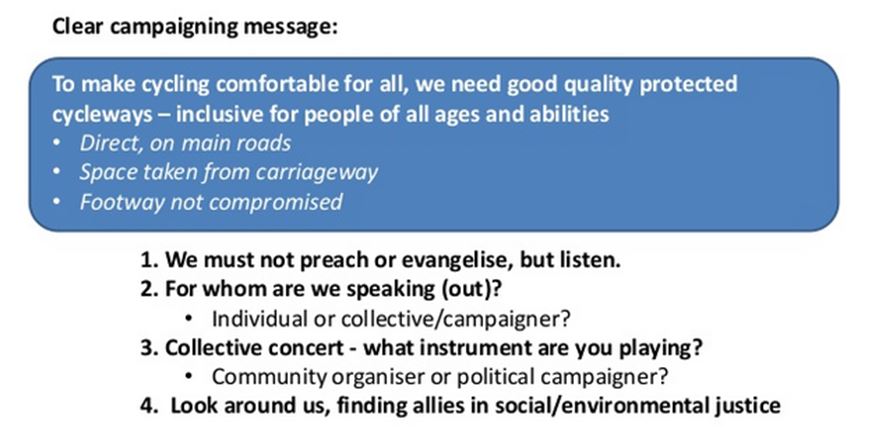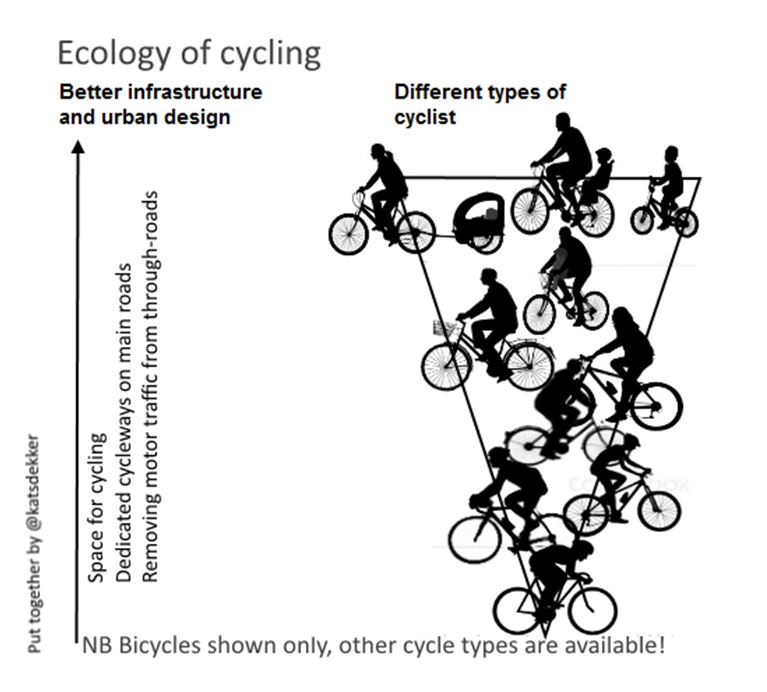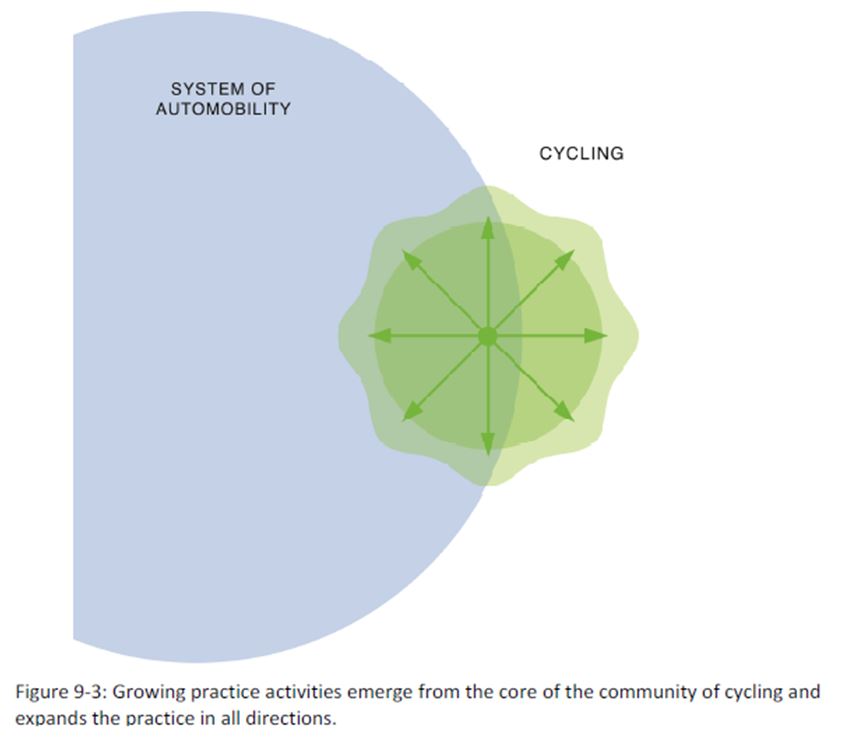Five key tips for the first time (or veteran!) cycling infrastructure campaigner
By Katja Leyendecker, Co-founder of NewCycling.org
Want more people to cycle? Campaign for cycling infrastructure. What happens next could be of interest to the cycle industry too. Here is just one story of many, the Newcastle story: In 2010 I co-founded newcycling.org, the cycling campaign in Newcastle-upon-Tyne, with my co-activist Claire Prospert – now 1,600 members strong with many of us giving freely our spare time to campaign for better cycling infrastructure in Newcastle. Our six year anniversary is coming up soon for newcycling.org. An anniversary always seems a good time to stop for a moment, and look back and reflect. So, after some early reflection, here are my top five campaigning tips, that I hope others may find useful. You can use these to start a new campaign, or you can use them to check your existing campaign against these five points.
Top Tip #1 – Be very clear about your  campaigning goal
campaigning goal
Understanding what you are campaigning for is key to successful campaigning. For Newcastle we knew it was the cycle infrastructure that is so sorely lacking (and hence the reason why so few people are cycling in Newcastle). We wanted to concentrate on seeing improvements in the cycling infrastructure, and broader urban design. It’s probably true, we don’t necessarily see ourselves as cyclists, more as urbanists wanting a better city. And yes, cycle infrastructure and road design are a super big thing to campaign for, but it’s a vital thing that’s needed in UK cities.
Once you have your goal, keep your aim… any deviations away from that, it’d be high time to reassess and ask your campaign if you are still doing the right thing, and adjust accordingly. Be organised, have annual meetings, have annual campaign plans. Be open about your goal, and publish everything that’s related to your activity. Yes, good organisation is vital.
Figure 1 – Campaign message. From my talk at Women and Cycling Conference in Hereford https://katsdekker.wordpress.com/2016/05/05/we-were-rocking-it-at-wacc2016/

Top Tip #2 – Understand your decision-makers
Now you have a goal and you have pinpointed the thing that needs to change. The next, logical, step is to locate the person(s) who can do something about this. Who holds the purse – and policy – strings? Who is your primary target? Who are you petitioning with your goal? Identify the people, assess the structure, find relevant forums and meetings you can attend.
It’s now that you should start thinking in political as well as institutional terms. The council (local authority) consists of two distinct elements: the body politic and the executive officers. Figure out where the decisions are made, officially and unofficially. And get under the skin of the institution – what really is their notion and attitude towards cycling, cycling infrastructure (and perhaps cyclists)? Find ways to explain and outline and sell your goal to them. And do not let the (often Kafkaesque) institutional maze hold you up.
Figure 2 – Find ways to present information to decision makers, example, from https://katsdekker.wordpress.com/2016/01/09/ecology-of-cycling-the-cyclist-you-design/

Top Tip #3 – Build your internal and external community
It’s amazing, really. But it is true. You can easily start a campaign with “only” a handful of dedicated people. Once you have a common goal (Top Tip #1) and you have identified your targets (Top Tip #2), you can effectively start campaigning. There are two distinct types of campaigners needed, as far as I have learnt. There are the political activists: they are the visible ones, turn up at council meetings, meet politicians, speak at council events, engage the press and media, and generally do what I suppose we’d traditionally call lobbying.
Then there is the community activist: they are growing the campaign from within, they reach out, sign up new members and turn up at community events and festivals, post events on the campaign website and the like. It’s important not to forget that a campaign also functions as a support group. You can run a campaign through lobbying only, but community outreach can be rewarding for a campaign too. A cycling campaign traditionally provides a shelter and safe space, a home to people who already cycle, and the activists give the campaign both an external and an internal voice and confidence. I would also recommend reaching out to people who don’t cycle. Because by doing so you are acknowledging and embracing barriers to cycling. You can incorporate the removal of these barriers in your campaign strategy. It’s quite inclusive. Keep an eye on gender, race, disability balance, and be critical with yourselves. Link up and work with other campaigns.
Figure 3 – A contested practice, growing practice, from Victoria Wesslowski PhD http://www.cyclingandsociety.org/wp-content/uploads/2015/10/CSS2015-Viktoria-Wesslowski-Presentation.pdf

Top Tip #4 – Creep under the skin of your local policy
Engaging with decision makers is great (Top Tip #2), but knowing their policies inside out is the fundamental fodder you can feed them. Policy is the vital puzzle piece that allows you to talk to decision makers on eye level. Carry out a policy assessment. Which transport and planning policies are in place? What do the policies say? What are the useful bits and pieces in these policies, on climate change, sustainability, active travel and cycling? Extract these sections, and engage your decision makers on them. More specifically, is there a cycle policy?
There may be some merit having a separate cycle policy document and it could be something worth asking the decision makers to set up. Even the process of setting up a cycle policy itself can focus and sharpen people’s minds to the cycling cause. Make sure ‘building a cycle network’ features heavily in the policy. A word of warning. Based on my experience from Newcastle, if one thing pains me to witness it is when people “stumble” at the policy hurdle: policy is an ass. Do not expect logic and rationality to prevail in policy! Policies are a weird mixture of wishlists for both change and tradition, and can quite often appear rather schizophrenic and contradictory in their content. See beyond it, and find the good bits you can use for your campaign. Should the policy be totally unacceptable however, you may like to devote time to campaigning for a new policy.
Top Tip #5 – Be courteous but firm and use media channels
You may have a great campaign goal such as ‘building cycleways on all main roads’, still, breaking this down into bitesized chunks is necessary. The decision makers can often not swallow much at any one time. So finding new angles and new vistas is important. Do not hesitate at all to package, and re-package. It may feel as if you are saying the same thing over and over again, but not everyone is listening all the time, unexpected windows of opportunity open and close all the time and contexts shift. What is said about horses and courses seems apt. Messages are often only heard when given repeatedly from different directions, people and in different voices. Experiment! See what works (and what does not).
In Newcastle we sometimes ran initiatives to engage our local politician / councillors (travel survey), or our members (tell us your story). And do not be shy to contact the media. Establish a rapport, perhaps get a contact person for your local rag, and feed them info, press releases, phone calls, meetings. And if anyone has figured out how to courteously address the UK’s brightly victim-blaming approach to road safety, please let me know.
This worked for us in Newcastle, I reckon at lot of it is generic and can work in your area too.
Above all, don’t forget to have fun!
Happy campaigning, everyone!
Need a bank of statistics, analysis and case studies to back your case for building for cycling? Dip into our dedicated Cycling Advocates’ Resource, a deep library to help you build a watertight case for investment.
Lead shot – Cyclists do count, from Katja Leyendecker



